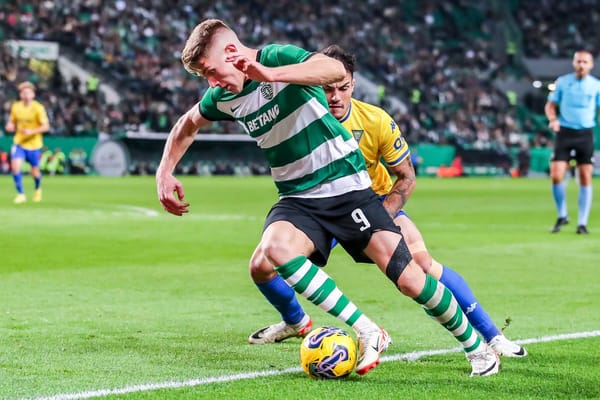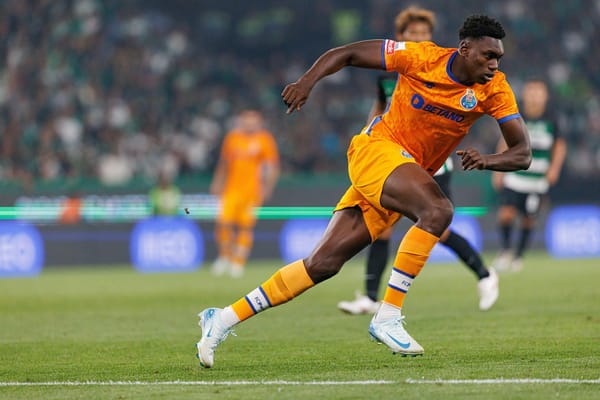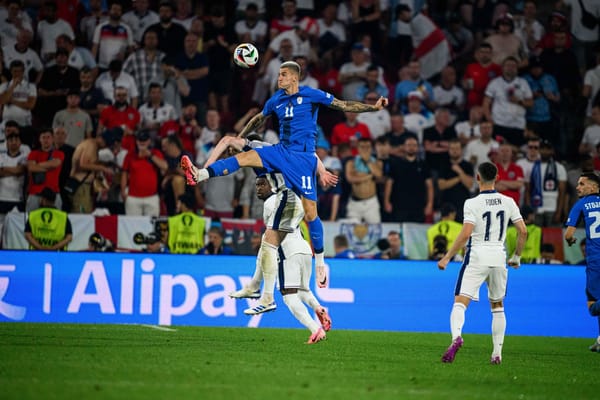Oriol Romeu: The perfect band-aid for Barcelona's Busquets-sized wound
Romeu’s comeback story begins now and hopefully, this time around, he will be able to fully show his worth.
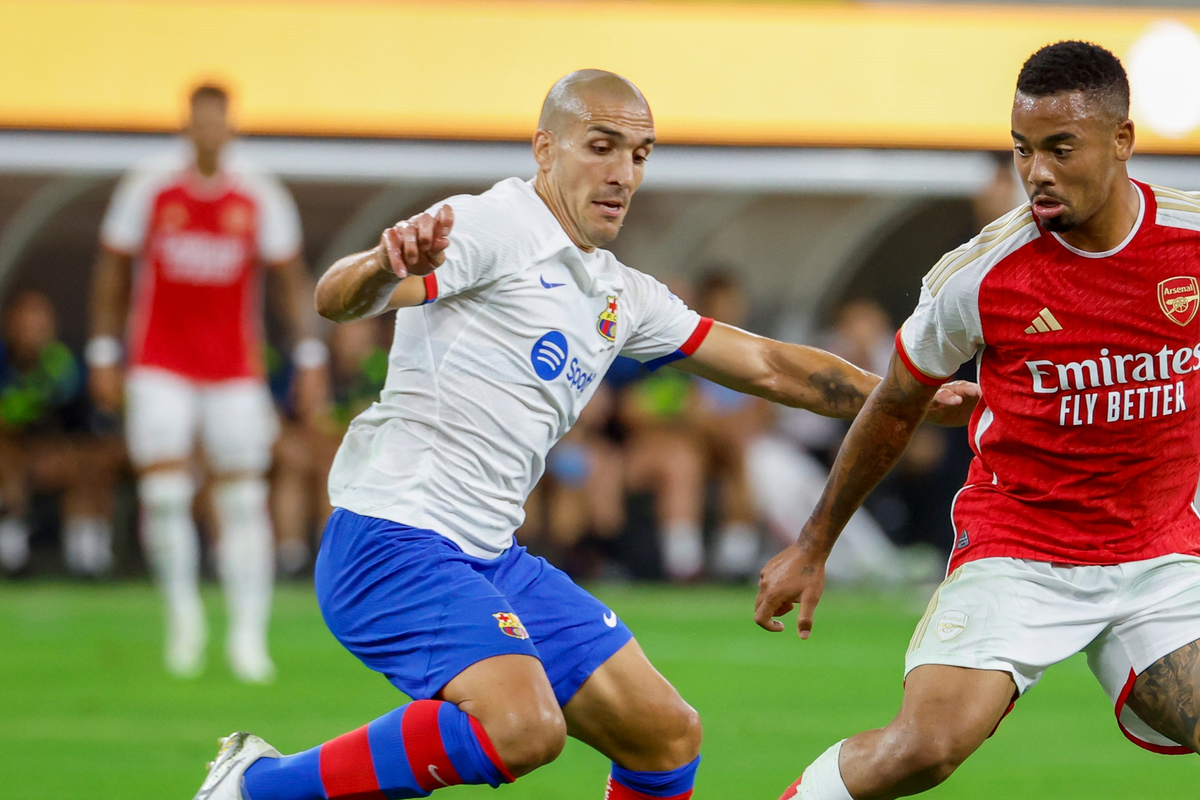
Replacing Sergio Busquets is a truly unenviable task; one Barcelona have been racking their brains about for years now. And now, it’s staring them right in the face. Of course, being broke doesn’t help and for that reason, Xavi has had to ‘settle’ for Oriol Romeu, ex-LaMasia, Southampton and Girona player turned (back) Blaugrana.
So how can this relative unknown step into the shoes of the greatest number six Barcelona - and the world - have ever seen? Simple, he won’t. But that doesn’t mean he won’t do well.
Let’s dig in.
Oriol Romeu, mental & body profile
Romeu stands at 183cm and weighs 83kg, boasting an impressively developed build with muscular arms and legs. With a very proportional torso-to-leg length ratio and high centre of gravity, the 31-year-old can eat up ground over longer distances with big strides but isn’t as mobile to accelerate and decelerate quickly. However, a big and muscular frame and big steps allow for firmer foot planting, making him both an immovable object and an unstoppable force in standstill duelling and full-stride motion.
This does take away some of his agility and explosiveness but can aid in raw power when shooting/passing due to stride length and foot planting before the contact with the ball is made. Romeu can also cover a lot of ground with great stamina and resilience, making him a great physical asset to the team.
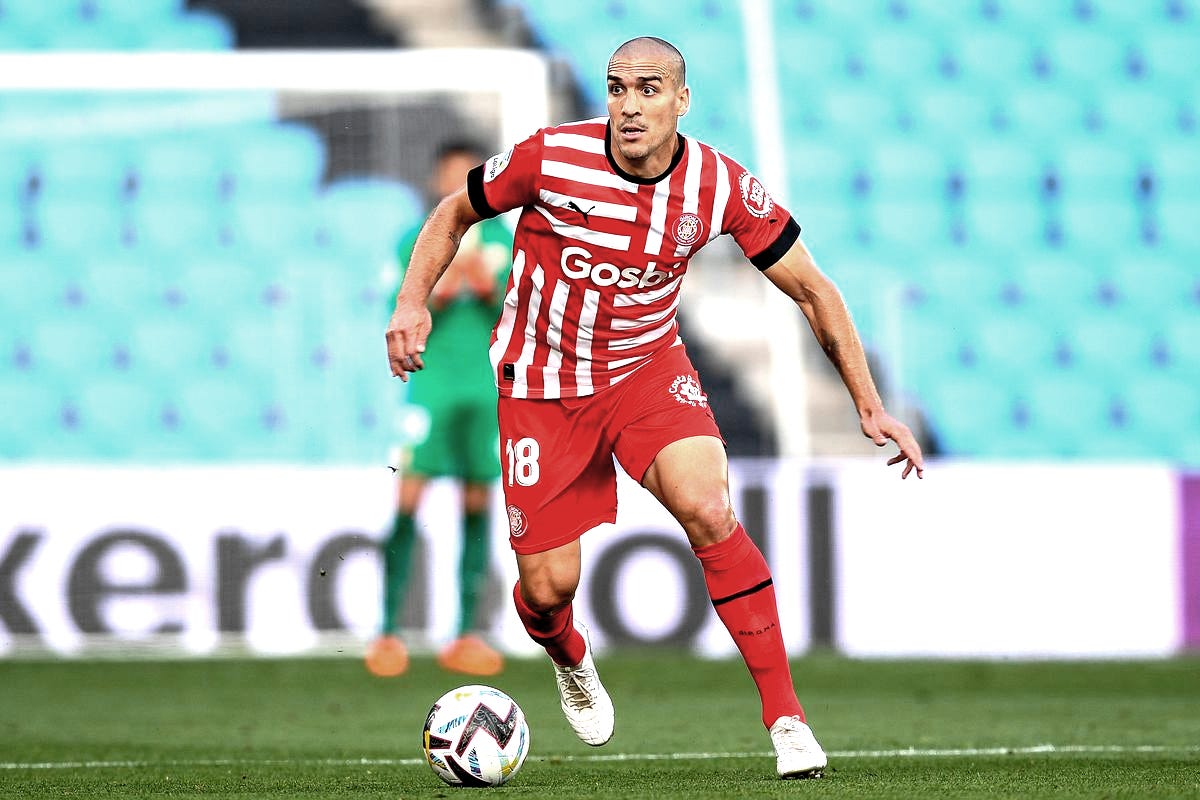
On the other side of the coin, the 31-year-old’s mental faculties are equally impressive; Romeu is hard-working and a leader on the pitch despite being quite introverted outside of it - always vocal, always directing and always instructing his teammates. He is diligent in tracking back and pushing forward and will make no excuses for it.
His physical and mental foundation is that of a disciplined, well-respected and courageous individual; a true professional.
Player profile
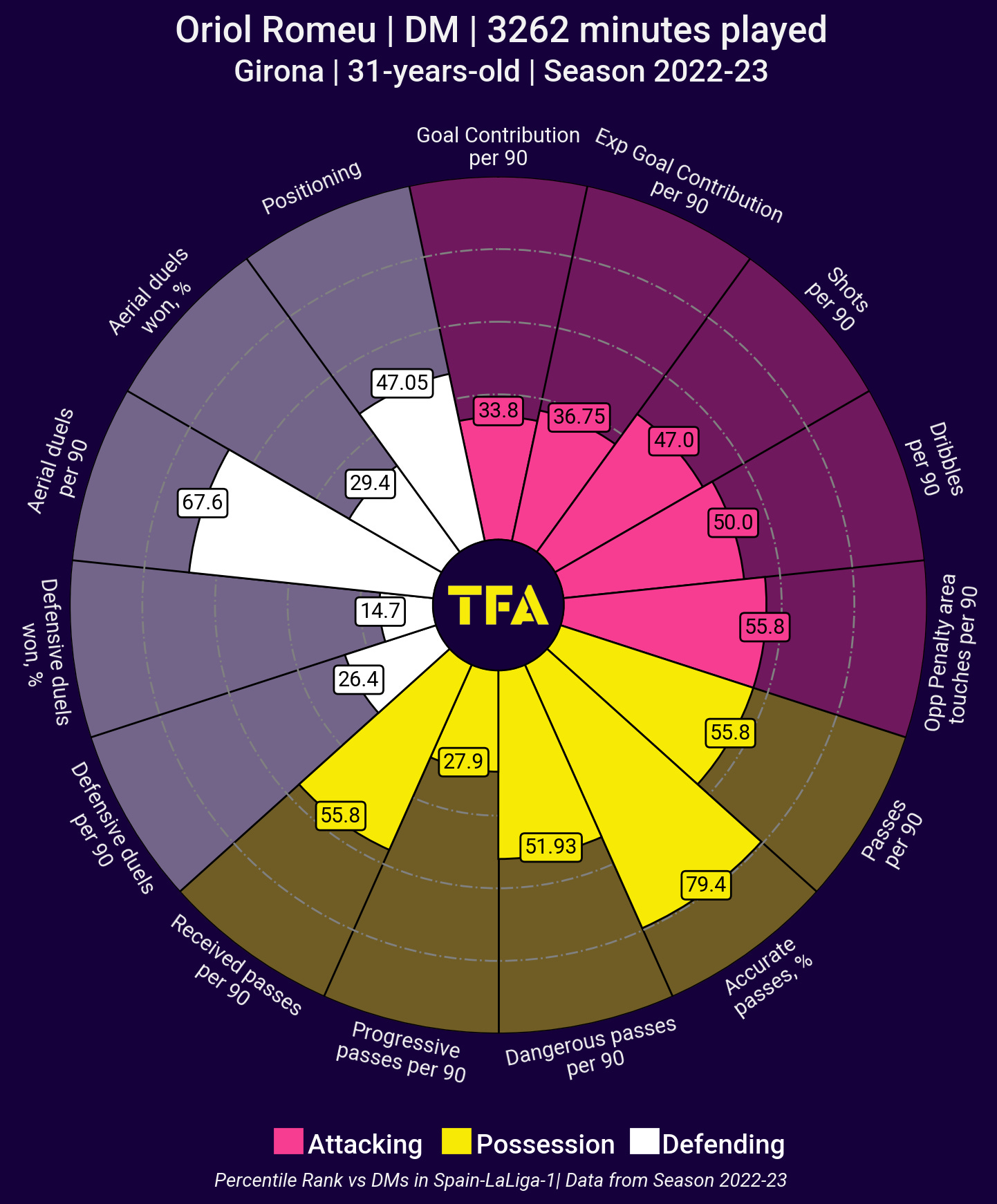
Romeu profiles as an anchor and a very tidy, safe and horizontal defensive midfielder. He’s steady, largely unadventurous and not flashy but consistent in execution, all of which are traits of a very standard, old-school but reliable number six. The graph above, kindly provided by TFA once more, tells us a very similar story too.
The 31-year-old’s role is best described as that of a recovery and retainer expert - he wins the ball back and is able to recycle it safely to continue the possession phase. In that sense, he’s someone whose first instinct is not to lose the ball as opposed to immediately going on the offensive. Stability above all. Girona were among the more exciting LaLiga teams in 2022/23 but in a team that can claim the spotlight through intricate sequences, Romeu is likely the least exciting cog in the machine. This, however, is the biggest compliment someone of his profile can get.
His role in Michel’s 4-1-4-1 is that of a balancer, not an aggressor; a steady tempo setter who tames the chaos, not produces it; a level-headed retainer who seeks to control, not aggravate. In his current form, Romeu is the perfect peace for Xavi’s war, a calm for the chaos and a touch of ‘common’ for the extraordinary.
However, there may be more to this simple ball-winner than it initially meets the eye.
In-possession value
Even without delving too deep into Romeu’s profile, we can concur he is no Busquets. But no one is. Not really. What he is, however, is someone who can replicate Busquets’ balance and composure when everything around him is on fire. In other words, he is the antidote for the overly vertical nature the current Barcelona team is often ‘plagued’ by.
When trying to determine whether his profile fits into the system, we first need to explain what that system is. In a box midfield, Barcelona play with a double pivot or two deep midfielders behind two advanced interiors. The ideal partnership, however, is generally comprised of two different but complementing profiles: a) A vertical, aggressive and adventurous player 1 and b) A horizontal, safe and positionally disciplined player 2.
This combination is optimal because player 2 enables player 1 and both players compensate for each other’s deficiencies. In this case, Player 1 gives you the progression and the creativity player 2 lacks and player 2 gives you the recycling and recovery player 1 lacks. Already, we can see how Romeu’s profile fits in like a glow next to someone like Frenkie de Jong in a double-pivot.
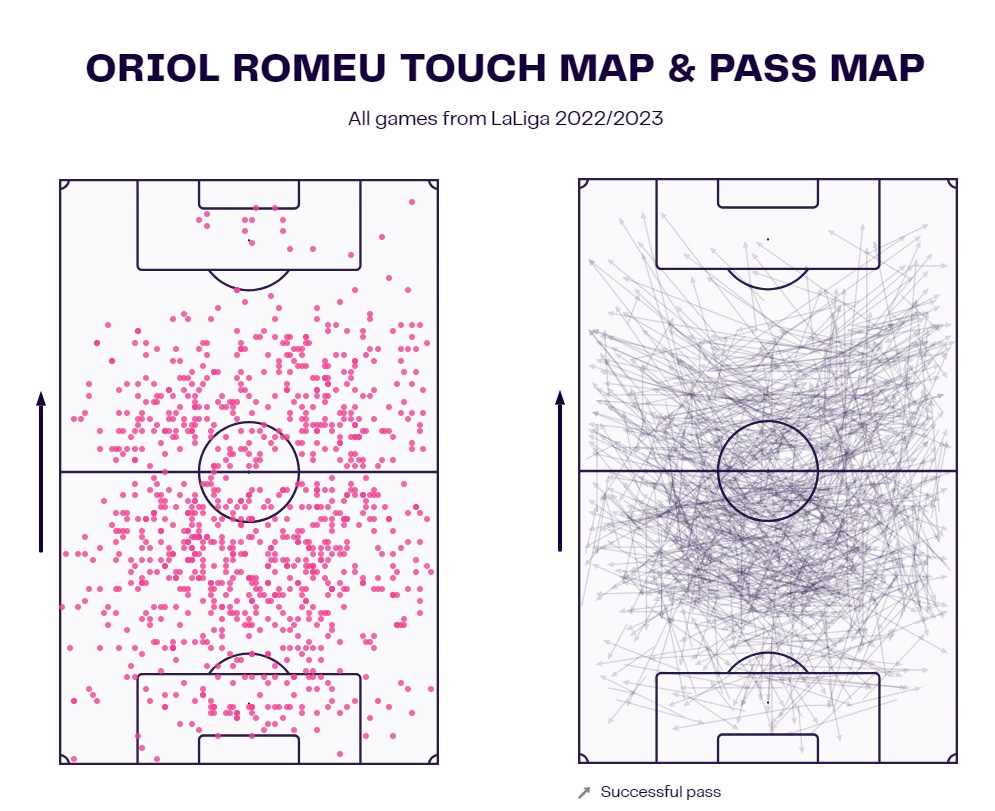
Above are Romeu’s touch and pass maps, provided by AnalyticsFC. The most important aspect of these maps are the locations - notice how Romeu is far more active in the deeper areas of the pitch and is more focused on horizontal passes (to either side) in his half of the pitch. This is exactly what a positionally disciplined number six is meant to do; Romeu is like an anchor who won’t abandon his area and is tasked with recycling and bringing stability.
His passing repertoire is quite limited but when it comes to short horizontal passes, Romeu is almost immaculate. Not only that but he boasts 89% passing accuracy across all competitions in 2022/23. Generally, the only instances where we would see longer passes is when Romeu shuttles the ball out wide or - far more rarely - threads passes into space. Both are options but the former is something he comfortably does on a consistent basis while the latter is more situational. In such instances, often higher up or just entering the opposition’s half, we will see Romeu switch the ball from one side to the other and be more vertical in his execution.

Above, for example, Girona have the opposition pinned and Romeu is effectively the last line of cover just ahead of his defenders. This is where his circulatory prowess takes a slightly different shape. He is still tidy and reliable but also becomes more adventurous and creative. In the instance, we see a fairly straightforward switch from right to left but Romeu strikes through the ball cleanly and shows he has these types of passes in his locker too.
This, however, immediately reduces the reliability of his delivery despite striking well through the ball with both feet as his long(er) range efforts are significantly less accurate. Interestingly, while he can and does use his left with more powerful, longer-range passes or shots, quick combinations can be tricky. Romeu tends to overhit and misplace his left-footed attempts, even over shorter distances, and generally avoids playing with it unless it’s just for reception and quick control.
This poses a number of other questions too: what’s Romeu’s potential as a lone six at Barcelona? How are his positional awareness and discipline? How does he retain immediately following a recovery? We already know Romeu can recycle the ball horizontally over short distances really well. In fact, it’s one of the most prominent traits of his profile. But his effectiveness as a lone Barcelona six is capped due to some of the limits of his profile.

The first of which is progressiveness, or lack thereof. Romeu is not a natural progressor despite occasionally being quite good at carrying the ball forward. Above are all of his progressive actions (carries and passes) from the 2022/23 LaLiga season and immediately, we can see the volume is quite low. For a player who has played almost every minute of a 30+ game season as a starting number six for a fairly structurally and positionally complex team, the numbers are quite unimpressive.
In fact, Romeu is relatively reluctant to ping passes into space from deep despite being able to. The compilations and highlights of his career would suggest otherwise but these types of flashy passes are an exception, not the rule. Interestingly, however, as you can see from the graphs above, the higher he is positioned, the more willing he is to be more adventurous. This goes in line with his core trait of safety first. Romeu is not a risk-taker so gambling with possession deep on the pitch goes against the crux of his profile.
There is, however, a much more exciting side of the ex-LaMasia product, one that gets missed by those who don’t look deep enough. Romeu is very conservative and tidy as the deepest midfielder but in the opposition’s half, he can be a much more dangerous threat. We can see it from his passes into (and around) the box from and around zone 14 and especially in his dribbling.
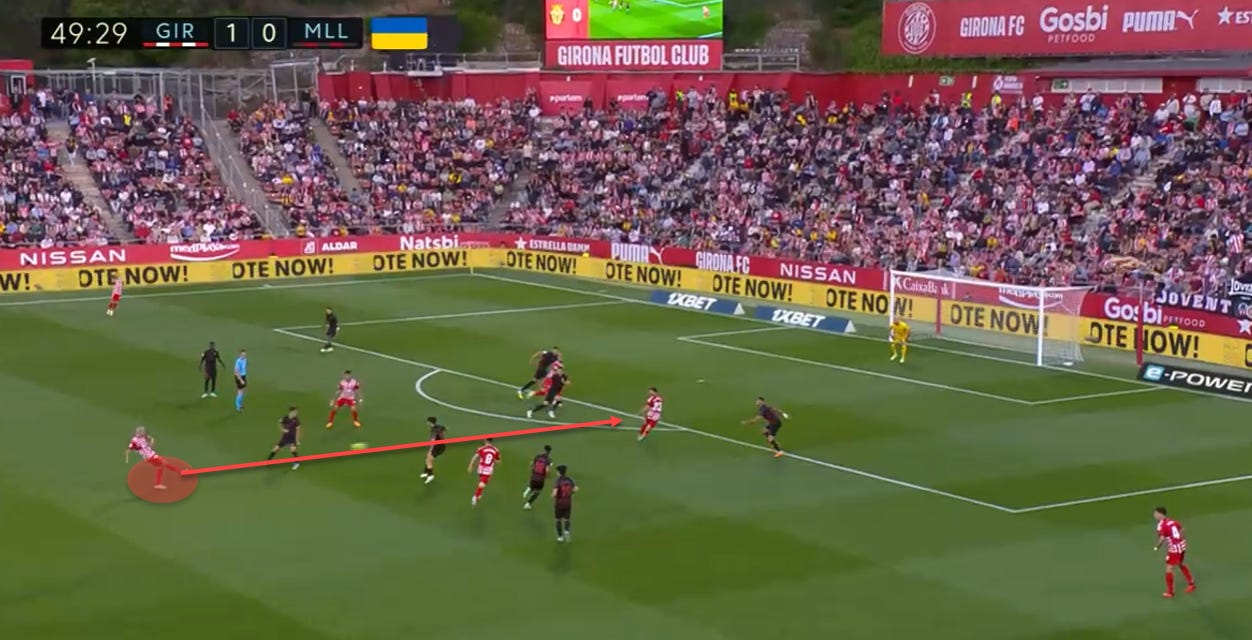
Here, for instance, we find the 31-year-old just at the entrance to the final third as Girona are on the offensive once more. Instead of going for a safe option to retain possession and keep the opposition pinned down, Romeu goes for a risky and yet ultimately successful threaded pass into the feet of an advanced runner.
Again, we’re talking about situational passes; exceptions, not rules. Surprisingly, despite that aforementioned safe nature, Romeu’s dribbling is also more effective in the opposition’s half. For a player of his frame, the 31-year-old is quite agile and explosive over short distances and can manipulate his frame well. This is a great tool both in defence and attack.
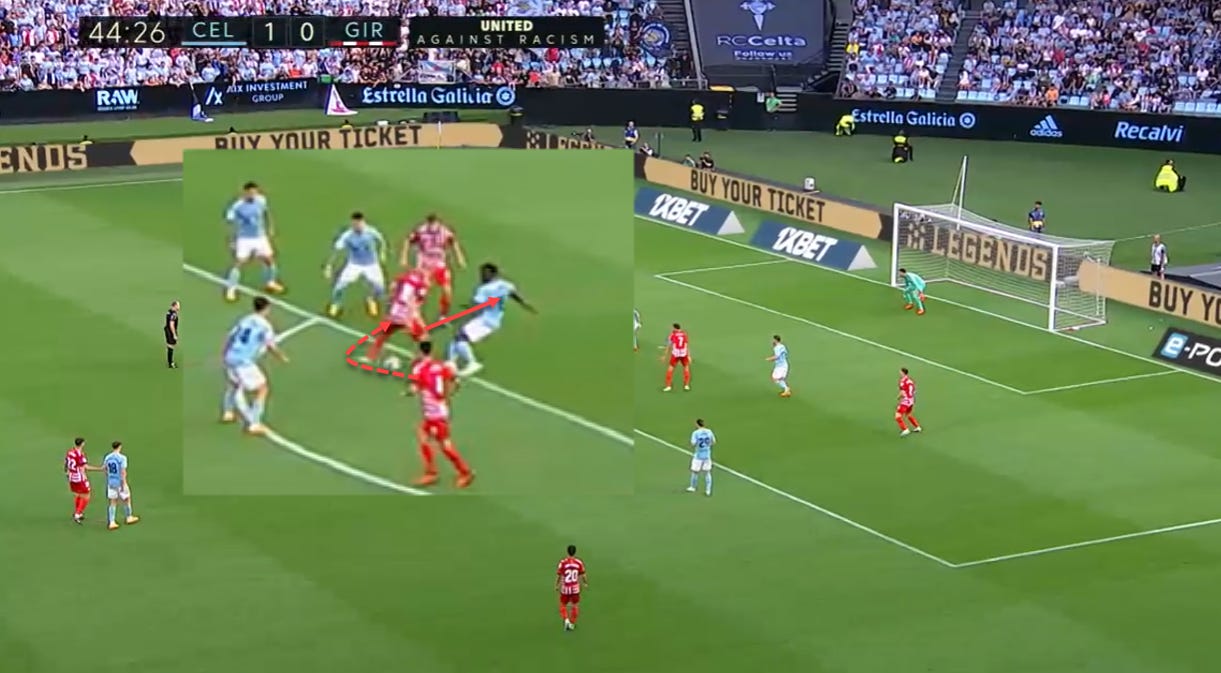
A very offensive example can be seen above as Romeu attacks the box from deep and uses quick feet to dance past the defender and then slip the ball into space for his teammate to run onto. It has to be said that this, again, is not a regular occurrence but just an example of the surprising technical level Romeu possesses. But at the end of the day, that should be expected from a player of a LaMasia upbringing after all.
On top of all of that, he takes quite a lot of shots for a defensive midfielder: more than every Barcelona midfielder in 22/23 other than Gavi who had four more but they scored the same number of goals (2). Still, his xG per shot was only higher than Busquets’ last season, which would confirm he’s not as big of a threat going forward as Barcelona’s other midfield options. But that goes without saying. Still, it’s quite interesting to note this other more creative, courageous and exciting side of Romeu. Maybe coming back to Catalonia rekindles the flame within?
Staying on the topic of his lone pivot limitations, though, the ability to recycle the ball quickly, using only one-touch passes, is not always on a Barcelona - or let alone Busquets - level. Yes, Romeu can handle volume and is used to being the first receiver ahead of the backline but he also tends to take at least two touches before laying the ball off. This can be problematic in tight spaces because he tends to hold onto the ball for too long and ends up scrambling for it.
Fortunately, however, in spite of this, Romeu still rarely loses possession, especially deep in his half. But the tendency to control with one foot and then pass the ball on with the other could cost him in a fast-paced Barcelona system where build-up has to be both smooth and rapid when necessary. His scanning proficiency and volume will have to increase as well, seeing how that often gets him into those tight spots in the first place.
Out-of-possession value
Given his role of recovering and retaining possession, Romeu’s out-of-possession value could be what makes or breaks his Barcelona stint. Interestingly, however, for a defensive midfielder, the 31-year-old is not a duelling machine. In fact, in the 2022/23 LaLiga season, he finished in the bottom 26.4% for defensive duels per 90 and in the bottom 14.7% for defensive duels success rate.
This tells us that he isn’t a volume dueler at all. As a matter of fact, Romeu is much better and more efficient at defending space than he is at direct duelling and man-marking, despite his good physical predisposition for the latter. As stated earlier, he can manipulate his frame really well, using his long legs and big strides to ride challenges and not get shrugged off. This is useful in 1v1 altercations.
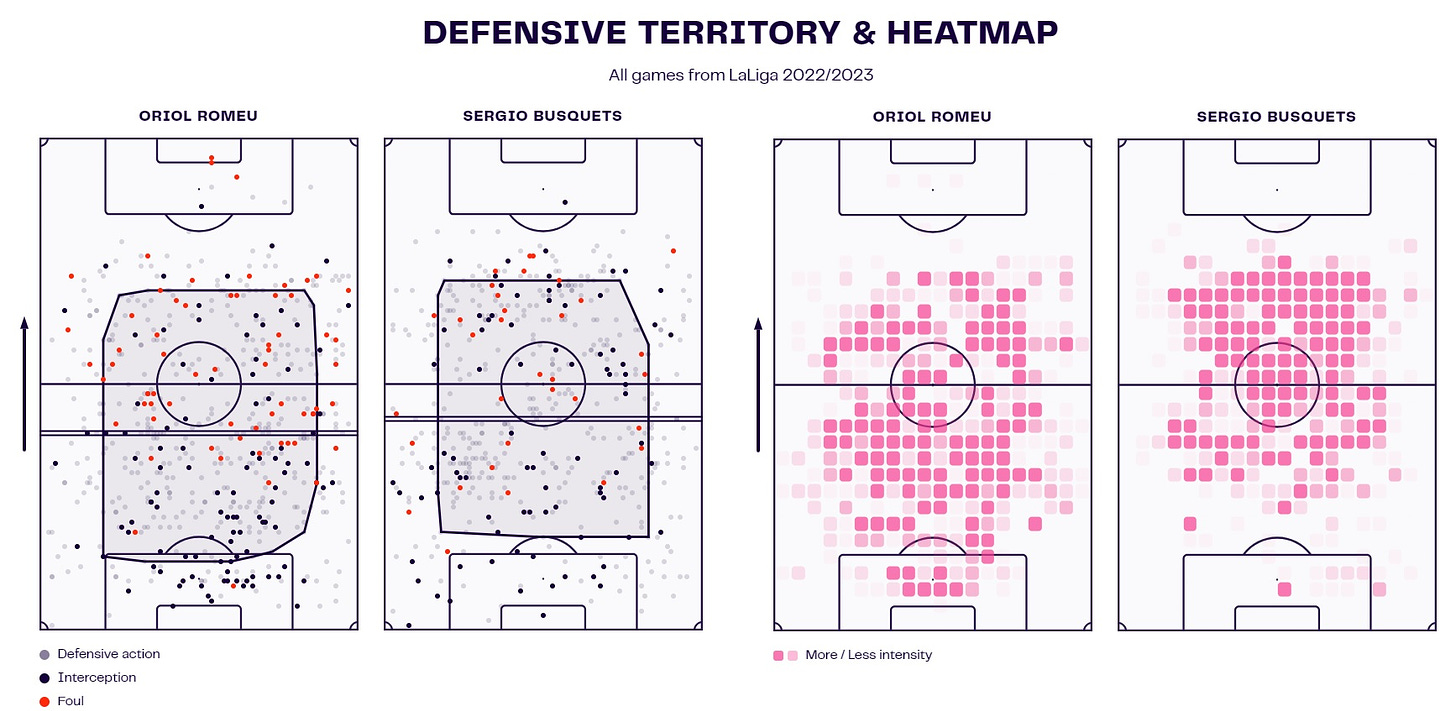
Above is the comparison between Romeu’s defensive territory and heatmap and Busquets’. Even though the former is not the latter’s direct replacement, qualitatively or otherwise, he will be performing some of Busquets’ tasks both in and out of possession. Looking at the defensive territory, we can see Romeu is much more active in deeper areas of the pitch and is used to operating in a slightly lower defensive line.
Similarly, he is much more active on the right side of the pitch, which is fitting as that is where he’d spend most of his time as the right-sided defensive midfielder in Xavi’s box midfield. However, even his defensive actions indicate lesser proficiency in duelling as the higher he gets on the pitch, the less reliable he becomes. Romeu isn’t a great pressing player and will often commit a lot of fouls when trying to push up the field. As this is generally when he’s forced into duelling and tracking his man, we can see this adds to our initial premise as well.
Another thing worth examining is the positioning. By tracking his interceptions and blocked shots, we can get a clearer picture of how well he positions himself to prevent shots, passes or runs. In other words, we see how well he reads the game.
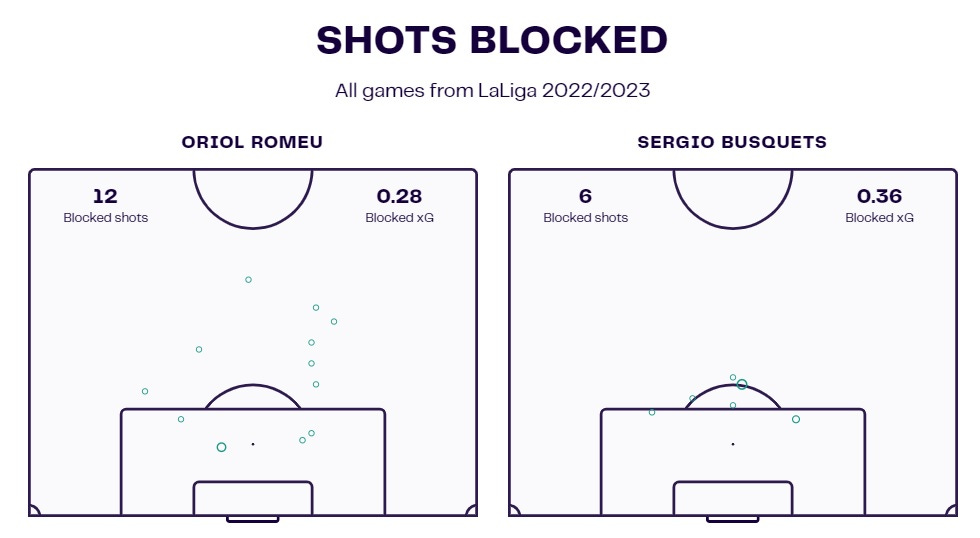
This is a comparison between his and Busquets’ blocked shots from the 2022/23 LaLiga season. While Romeu does have double the blocked attempts, Busquets still recorded more blocked xG overall, meaning he’s dealt with more threat than Romeu has. That said, the sheer volume is still a good sign as it shows us the player is clearly good at reading the opposition’s play, which, again, feeds into the narrative that he interprets and defends space really well.
Another thing Romeu adds is the rest-defence and defensive transitions proficiency, both crucial for Xavi’s system. Running in big strides and being able to ramp up speed over longer distances with admirable stamina, the 31-year-old is someone who regularly tracks back and can keep up with transitional threats. Very agile and pacey forwards can outmanoeuvre him, though, because of his flat-footed approach to such situations. Fortunately, his decent recovery speed means that doesn’t immediately eliminate him altogether.
Still, given his proclivity to defend space well, Romeu is excellent at breaking up the opposition’s play and then restarting the attack. This is key for his role at Barcelona. After a successful recovery, Romeu’s first instinct will be to retain possession, not jeopardise it, meaning the first passes he makes following that recovery will be safe and largely horizontal.

The example above illustrates this almost perfectly. Romey is behind the opposition’s players, not sticking tightly onto them but rather focusing on the space behind their backs. However, once he recognises where the ball is going to be played, he springs into action, quickly covering enough ground to intercept the pass.
Immediately following that, he recycles the ball to his nearest and safest teammate rather than playing a penetrative pass into the feet of the two runners to his left. It’s not so much that he can’t play those passes, it’s more that he refuses to. Besides, we see it in his body language too as the 31-year-old immediately signals to his teammate to slow down and wait.
This can be seen below in Pranav’s excellent graph too.
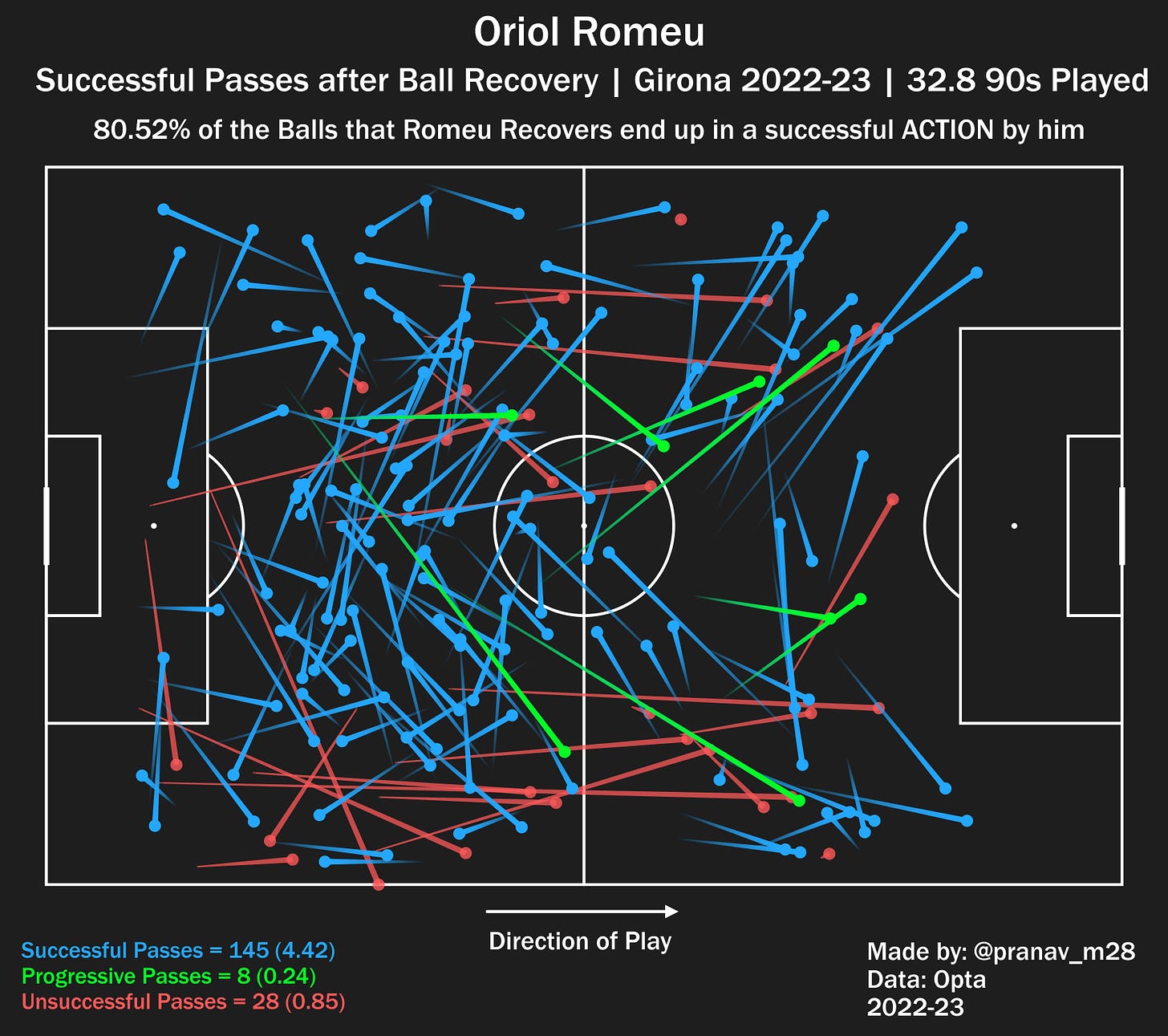
Out of the total of 181 passes following a recovery, 80.52% were successful and a large majority were horizontal or recycling in nature. Needless to say, this will be crucial for his stint at Barcelona and goes hand-in-hand with the in-possession role we analysed earlier.
Potential setups
With a rather simple role, there’s not much uncertainty around Romeu’s potential positions at Barcelona. In case Xavi persists with the box midfield, which is a real possibility, the ex-LaMasia talent will slot into that right defensive midfielder role next to someone like De Jong.
This is pretty straightforward because the Dutchman takes care of the progression and creativity while Romeu stays horizontal and sweeps behind his midfield partner. Things get more interesting when we consider Romeu as the lone six in a 4-3-3. We’ve seen that some of his deficiencies put a cap on the potential he has as a lone Barcelona pivot and the system would have to compensate for that.
For instance, inverting the right-back or dropping one of the 8s would almost be a necessity to get the ball moving vertically, precisely and at the required speed from the deep areas. While this isn’t a fatal flaw for the system, it could take away from the efficiency you get from players like Pedri or Gundogan when they are played closer to the opposition’s box.
Another very important aspect is the defensive system. Barcelona have been dancing between a heavy man-marking and a thin hybrid pressing shape but mostly relied on the former. This goes against what Romeu is actually good at. Despite his physical foundation, the 31-year-old is not a duelling monster and his challenges higher up the pitch are more reckless and generally less reliable.
The numbers support that and so does the eye test; his flat-footed approach is somewhat mitigated by the surprising agility due to great body manipulation but getting burned in 1v1s, especially against opponents running at him, is a cause for concern.
All of that points towards a potential switch in defensive approaches to get the best out of Romeu and the team as a whole. That, however, is a topic for another time.
Final remarks
Comparing Romeu to a band-aid that will attempt to cover the giant void of a wound at this Barcelona team wasn’t meant as an insult; it’s simply a way to describe the magnitude and the sheer impossibility of the task at hand. Can Romeu replace Busquets? No. But he can do an incredible job as a short-term fix, not an outright solution.
By signing Romeu, Barcelona are simply sprinkling little drops of water on a burning house, hoping it somehow extinguishes the fire. Again, this is not a slight on Romeu. Not even close. He’s a player that I believe will surprise a large majority of people with his quality and the sheer fit of his profile. But it will only scratch the surface of Barcelona’s quest to fully replace Busquets.
Either way, Romeu’s comeback story begins now and hopefully, this time around, he will be able to fully show his worth.
Good luck.

